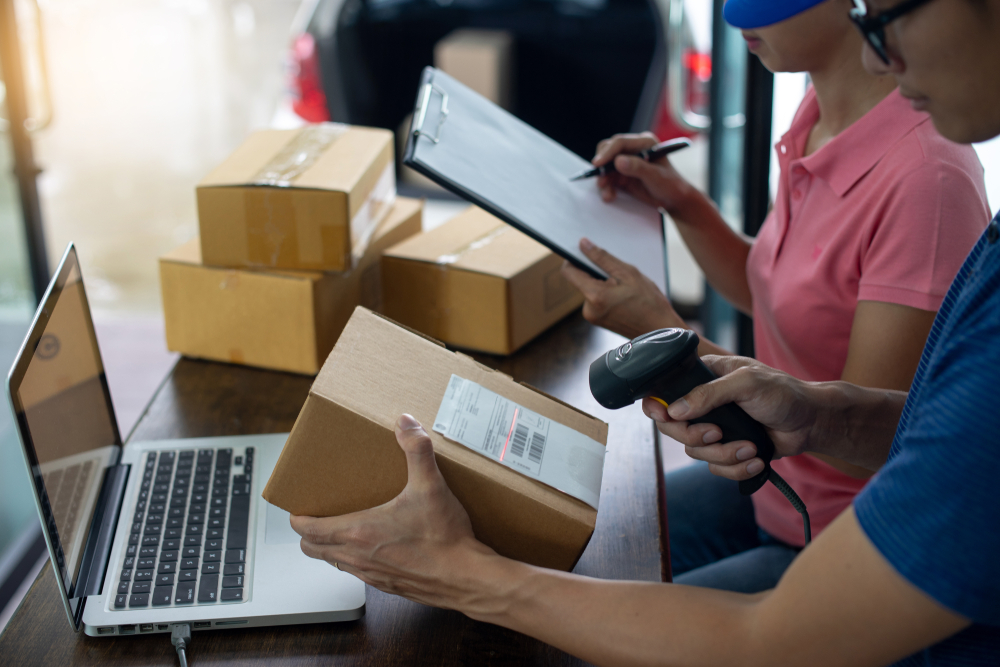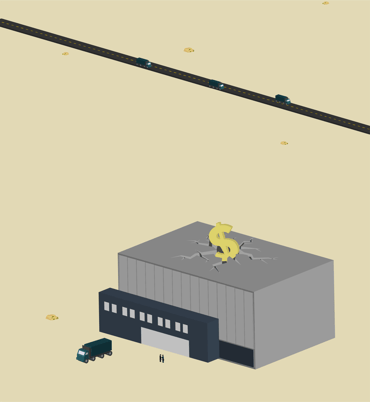Hyperlocal Fulfillment: Models, Benefits, and Considerations

With all these pressures, it's no wonder logisticians are being creative in designing fulfillment networks. It just makes sense to bring the fulfillment centre closer to the customer, when the last mile is proving to be such a costly challenge.
Hyperlocal fulfillment takes advantage of shorter delivery distances to increase the speed of order fulfillment and reduce delivery costs. It leverages underutilized retail and urban real estate to offset the costs of larger DCs on the periphery.
Micro Fulfillment Models
Hyperlocal fulfillment uses relatively small fulfillment centres, often automated, delivering in a tight radius, on a very constrained schedule. Not everybody does micro-fulfillment the same way. Some are taking underused retail stores and closing off a section to create a mini-DC in the 'back room', leaving part of the store as customer-facing retail; others are repurposing entire department stores, or smaller retail units into pure-play small fulfillment centres or 'lights out' stores. Still others have conceived of tiny fulfillment centres that stand alone in the parking lots of retail malls. All of these models can provide home delivery, BOPIS, or one of the other pick-up types.
Examples of retailers adopting hyperlocal strategies include Target, which in 2017 announced it was refitting 600 retail locations into micro-fulfillment centres, with both delivery and pickup available.[11] Grocery chains like Albertsons and Walmart have also piloted or rolled out micro-fulfillment centres.
Rapidly developing automation technologies are supporting this push. The use of automation is paramount – it speeds up picking, reduces labour costs and can achieve much greater storage density than the traditional aisle-picking model. Automation is permitting the use of smaller footprints by densifying storage. With AS/RS technology mini-DCs can rise many stories on a small footprint, which allows for the use of existing urban buildings, as well as the construction of newbuilds on small lots.
According to third-party robotic fulfillment provider, Common Sense Robotics, grocers lose US$5 to $15 on every manually picked online order because each $100 order requires an hour of picking at $20.[12] They have already launched the third-party logistics version of hyperlocal distribution, offering turnkey fulfillment services to grocers from a network of local, fully automated DCs they are building.
Takeoff Technologies offers an alternative model, using underutilized space inside existing retail stores and building fully automated storage and retrieval units (AS/RS) that take up about 10,000 square feet. The company recently signed a deal with integrator Knapp to open 50 sites across North America. Takeoff claims they can build and open a new facility in just a couple weeks.
Benefits
Hyperlocal fulfillment appears to be one workable solution to the omnichannel e-commerce challenges facing retailers today. Faced with the apocalyptic four horsemen described above online retailers can use the strategy to reduce the costs associated with last-mile delivery.
Moving the product closer to the customer before fulfillment reduces the time and distance of delivery. It takes advantage of underutilized retail assets by enabling existing storefronts to section off a 'back room' where orders can be fulfilled automatically. Alternatively, it leverages less attractive inner city real estate, allowing for all-new micro-DCs to be opened where traditional retailers have abandoned ship. Finally, automation reduces labour costs and increases accuracy and speed. This streamlined model delivers the higher accuracy and faster speeds that bring customer satisfaction, and in the e-commerce environment, good reviews can mean the difference between business success and failure.
 Some large enterprises are integrating a hyperlocal strategy into their overarching distributed order management model. Distributed order management (DOM) uses an algorithm to determine the lowest cost method of fulfilling an order. This means it can take into account factors such as the locations of both the stock and the customer, the available time to fulfill the order and shipping costs for various options. When integrated with a hyperlocal DC network, the DOM system can decide if picking the goods from the most proximate micro-fulfillment centre to the customer really will create the greatest profit for the order.[13] While this level of sophistication is currently only viable for large companies (like Home Depot which is using it), as the price of powerful big data-crunching computing power comes down, such sophistication may become to norm.
Some large enterprises are integrating a hyperlocal strategy into their overarching distributed order management model. Distributed order management (DOM) uses an algorithm to determine the lowest cost method of fulfilling an order. This means it can take into account factors such as the locations of both the stock and the customer, the available time to fulfill the order and shipping costs for various options. When integrated with a hyperlocal DC network, the DOM system can decide if picking the goods from the most proximate micro-fulfillment centre to the customer really will create the greatest profit for the order.[13] While this level of sophistication is currently only viable for large companies (like Home Depot which is using it), as the price of powerful big data-crunching computing power comes down, such sophistication may become to norm.
While the jury is out on which hyperlocal fulfillment model might work the best, as consumers continue to demand faster delivery and the availability of more products delivered to their doorstep or a local pickup point, retailers need to continue to explore ways of making a micro-fulfillment system work for them. This is not a sci-fi fantasy world; it's real now.
The trend is also generating side benefits for the logistics industry itself. The growth of the last-mile challenge has pushed the development of new technologies like automation, robotics and drones. New automation and robotics technologies are already seen operating within the tiny DCs, and are proving to be a success.
Drones are still on the cusp of commercial practicality, but various local delivery trials are demonstrating that the airborne AGVs may yet be used for e-commerce deliveries, dropping parcels off at the equivalent of super mailboxes. These special landing pads will receive the parcels and act as pickup points for consumers. Perhaps even sooner we may see robots on the sidewalk, making deliveries for local retailers. Lowe's, for example, is trialing a FedEx delivery robot for same day local orders. It can navigate sidewalks and steps to reach individual homes, and will be able to interface with a human recipient.
As hyperlocal fulfillment becomes normalized, demand will rise for these delivery options and will help to spawn yet others. Those technologies that can most quickly, cheaply, accurately and reliably move parcels from the local hub to the home will be the winners in the hyperlocal fulfillment game.
Operational Considerations
With automation doing the bulk of the work, these micro-DCs can operate with very little human labour, relying on people essentially only to manage replenishment and order completion. This makes them less expensive to run, but also highly reliant on properly functioning software to ensure demand forecasts are accurate.
When operating a small, quickly turning inventory the risks of stock-outs are high, making timely, accurate replenishment a key operating function. As we know, ensuring inbound deliveries to the old-school distribution centre are timely and handled efficiently is difficult enough. Setting and keeping appointments, managing the comings and goings to drivers and trailers is a delicate tango, best managed by a sophisticated scheduling software package such as we offer with C3 Reservations.
When you change the game so that the micro-DC is located in a busy downtown core it's a different world. Imagine dealing with these risks and realities:
- Few or possibly even no dock doors.
- Because of the limited storage space involved there will be only small quantities of each SKU on hand, meaning replenishment will be frequently required.
- More frequent replenishment will mean more, smaller trucks on the road, creating more complex schedules.
- Routing of inbound loads will be more complicated than traditional store replenishment. Will there be one truck making multiple drops or multiple trucks with a full load for each DC?
- Traffic congestion will cause unexpected delays or even missed inbound deliveries.
- With smaller staffs there will be fewer workers on hand to step in to unload trucks more quickly in the event of a late arrival.
- Delivery times may be restricted by municipal bylaws governing noise and emissions.
- There will likely be nowhere for trucks to wait if the dock isn't available when they arrive.
Under these circumstances this has to be precision warehousing. The margins for error are miniscule. That's why, in addition to the complex algorithms needed to make the automation churn out orders for rapid fulfillment, the logistics manager in charge also must be able to see – and more importantly control – what's happening on the inbound side.
Being able to rely on a proven Dock Appointment Scheduling system to manage inbound schedules means having more time and resources to devote ensuring that the orders going out the door are on time and 100 percent accurate. With such complexity it’s critical to have application software that will integrate seamlessly, is cloud-based, and flexible enough to manage so many moving parts at the same time.
REFERENCES:
11 "Target to recast stores as 'hyperlocal' fulfillment centers to revive ailing business", Barbara Thau, Forbes.com, February 28, 2017.
12 Crossing the grocery e-commerce Rubicon, Commonsense Robotics Ltd, January 2019.
13 Making the last mile pay", Capgemini, July 2017

